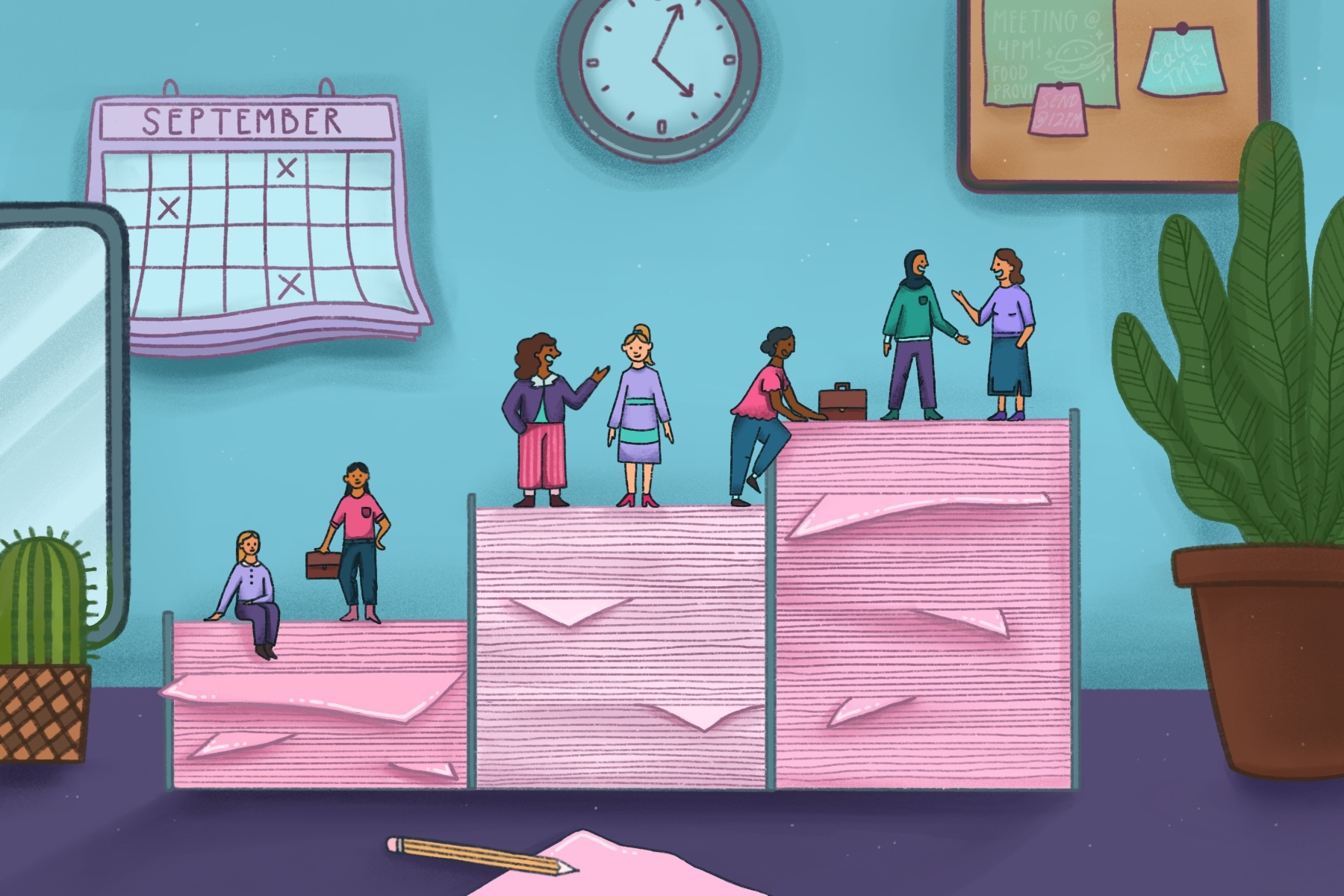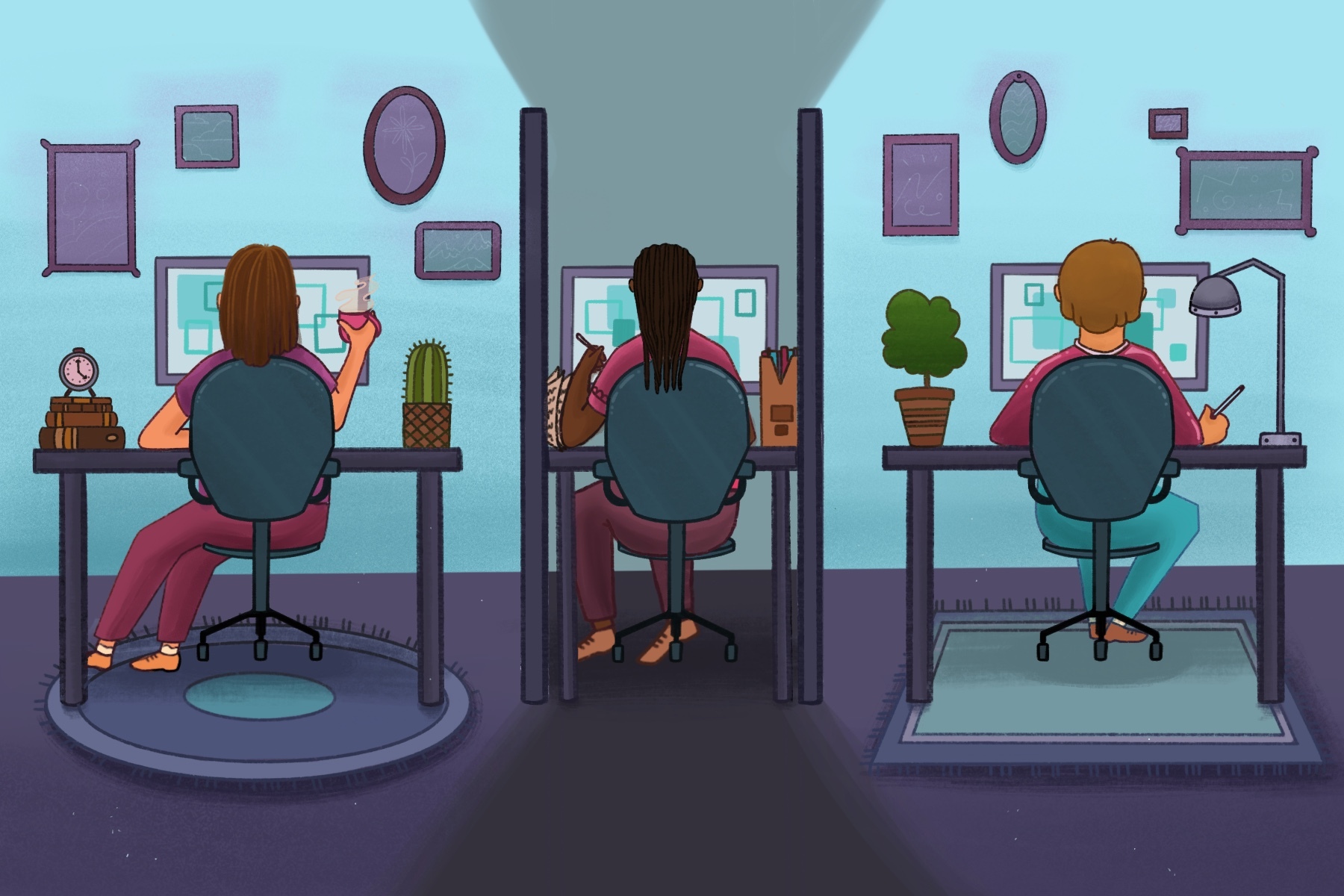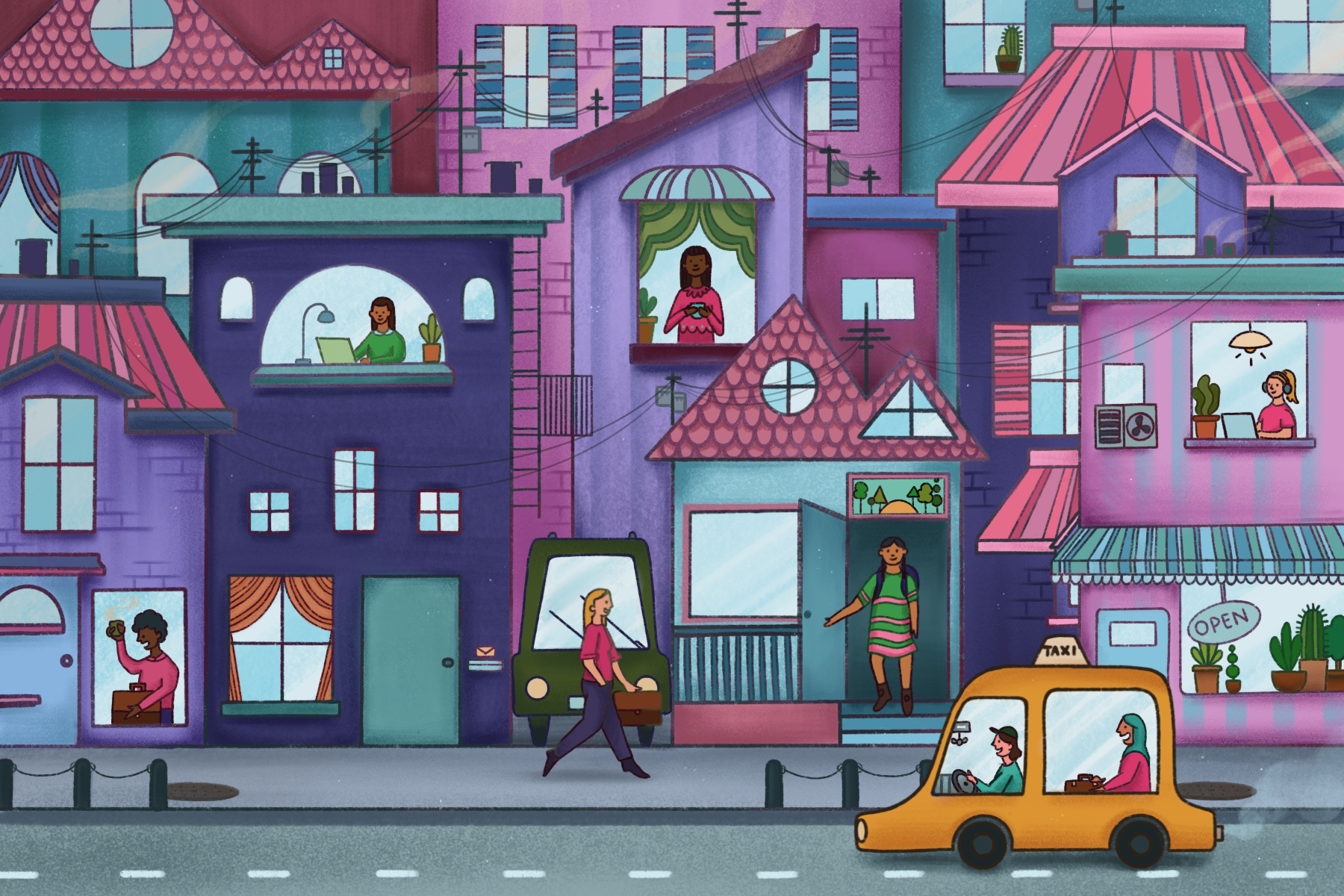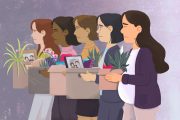Your trusted source for contextualizing business & economy news. Sign up for our daily newsletter.
When the COVID-19 pandemic hit the labor market and women lost millions of jobs, the country plunged into the first women’s recession. It was the first time women had experienced more job losses than men in one catastrophic economic contraction.
Economists feared it could take decades for women to recover. But just three years later, that recovery has already arrived.
As a group, women are back to pre-pandemic employment levels. They are now half of the labor force — a threshold they have crossed only twice before. And prime-age working women, those ages 25 to 54, have led that recovery, forging ahead into new careers, pushing for jobs with better pay and benefits and reaping the rewards of workplaces that are more accommodating of remote work, which often allows them the flexibility to manage caregiving responsibilities.
Still, not all workers have had equal access to that changed workplace landscape. Though they have made gains, Black women, in particular, have recovered more slowly considering how hard they were hit by job loss at the start of the pandemic.
“It’s not the economy that’s resilient,” said Jocelyn Frye, the president of the National Partnership for Women & Families. “It’s women that are resilient in that economy. I never underestimate the ability of women, generally, and women of color, specifically, to basically absorb the shock of a moment and sort of make it work. We have an economy that has largely been built on the backs of women making it work.”
In August, the labor force participation rate for women ages 25 to 54 was 77.6 percent, compared with 77 percent in February 2020 just before the economy crashed. That figure represents the share of women in that population who are working or actively looking for work, and it’s a key metric to assess the health of the economy. It’s also a milestone: Women in that cohort have remained at or above 77.5 percent since April of this year, marking the highest recorded rates in history. There’s also evidence much of that rebound was driven by women with young children, with the labor force participation rate for women with children under the age of 5 around 70.4 percent — an all-time high, according to a study by think tank the Brookings Institution.
By comparison, prime-age working men have also recovered, but by a smaller margin: Their labor force participation rate was 89.3 in August, compared with 89.2 pre-pandemic.
Women are also back as 49.9 percent of the workforce as of August, on par with highs in the second half of 2009, as more men lost jobs in the Great Recession, and in mid-2019, just before the pandemic and the women’s recession started.
It’s an economic U-turn. Part of the reason the pandemic was so devastating for women at work is because it eliminated more jobs in sectors that women dominated, particularly in the hospitality field. Women were also the majority of essential workers, those who continued to work as COVID-19 spread because their jobs were considered critical — nurses, grocery clerks, child care workers, home health aides. On top of that, women served as the primary caregivers to their children, who were out of school or day care for months, and their aging parents as they tried to protect them from COVID-19. The job loss of 2020 wasn’t driven just by layoffs — it was also driven by people, especially women, quitting their jobs when those caregiving duties collided with a job market that has little built-in support for them.
That period recalibrated women’s relationships with the workforce after many hit their lowest career points in 2020.

That’s what it felt like at the time for Stephanie Lanni, who joined a conference call one day in October and learned she and other workers across the country were being laid off at the American Cancer Society, the nonprofit where she had worked for eight years. She slid into severe depression, she said. But the experience also forced her to stop and reassess what direction she wanted her career to take.
For several years, she’d been doing small, $100 family photoshoots for friends. Suddenly, she wondered if her hobby could become a career.
In December of that year, Lanni penned a long reflection on Facebook about what had been a “tough, tough year” for her: “These next two months will be pivotal to see if I can stay full time with photography or job search,” she wrote then.
Now, three years out, Lanni is running a successful wedding and couples photography business out of Tampa, Florida, earning just about three times her nonprofit salary. She’s come off her depression medication, which she credits to the job change, and she has more flexible hours to make her own schedule.
“If I could see myself now three years ago, I would be so relieved,” said Lanni, 32. “That was such a low place for me where I was so worried about what was going to happen with my life.”
The economic recovery has been helped along by government intervention as much as a cultural shift in how work is structured, changes that could all improve workplaces for women in the long run.
Enhanced unemployment insurance during the pandemic and the Paycheck Protection Program loans to help businesses keep workers employed were key policies, economists said. Neither of those initiatives ran smoothly — both were marred by a significant amount of fraud. But when they did work, they were able to give workers some stability, and that made a difference, said Kate Bahn, the director of research of WorkRise at the Urban Institute, which is focused on labor market solutions for low-wage workers.
“When you maintain someone’s income, you not only maintain their ability to consume, but you give them a better foundation to be able to make better changes in the labor market,” Bahn said.
That foundation gives workers the wiggle room to make choices about what kinds of jobs they want to have instead of forcing them into whatever job they can find, even if it might come with lower pay or benefits.
Women also led union organizing in workplaces over the past three years as actions swept the country to help low-wage workers secure higher pay and better benefits for a population that is disproportionately women of color. Movements also picked up in states to pass paid sick and family leave after those benefits were enhanced for a time during the pandemic. Since 2020, five states have passed paid family and medical leave laws, and an additional three passed paid sick time laws. Two states passed both kinds: Minnesota and Colorado.
“The work that was done, the push to have some access to paid sick days, some infrastructure investments on child care — those investments mattered enormously. You can’t discount that,” Frye said. “All of those things helped to accelerate a recovery.”
In Los Angeles, the switch to remote school allowed Chloe Corcoran to pick back up the final class she was missing for her doctorate in higher education leadership. She is now working to complete her dissertation and has moved from a remote job in alumni relations for Emory University to another remote position at Palo Alto University that afforded her the opportunity to move to a more managerial position that felt more purpose-driven, she said.
“The pandemic really changed the way that I looked at work,” said Corcoran, 41. “We are looking at all those people who are struggling. ... It came back to, ‘How can I help people on a little bit more of an individual level?’”
-
Read Next:
The acceptance of remote work, and expanded access to it, has also shielded her from much of the harassment she has faced in the workforce as a transgender woman. More than any other LGBTQ+ group, trans women face the most discrimination at work, with about half reporting that discrimination has affected their financial well-being, according to a 2020 study by the Center for American Progress, a liberal think tank.
That’s why it was difficult, Corcoran said, to travel to Georgia regularly when she worked at Emory and worried about her safety in a state that has tried to block gender-affirming care for trans youth and, in at least one school district, banned certain books about LGBTQ+ people. Corcoran was also concerned how much longer her Georgia plan would cover her care in California.
“This isn’t really overstating it, every time I leave my house I have to be aware of the potential threat of violence against me, whether it’s verbal or physical — it exists,” she said. “Being able to lessen those opportunities for people to kind of have something to say or do to me, it helps the anxiety.”
In her new job, her “gender has never been an issue,” she said. “It’s more about: ‘Are you doing good work?’”
It’s still unclear how trans women and other LGBTQ+ people have fared since the start of the pandemic. The Bureau of Labor Statistics does not collect data on nonbinary people and does not have additional data on other LGBTQ+ groups. The most comprehensive data on trans people, the U.S. Transgender Survey, will be released later this year with data on the pandemic.
It’s also not entirely clear why the recovery for women, which on almost every count has been strong, has not been quite as strong for Black women, especially. The data collected each month since the pandemic began has been a lot less reliable than years past because of lower overall response rates on surveys.
What is clear is that Black women are still experiencing an unemployment rate that is about twice that of White women, and one that rose in the spring and has continued to hover above 5 percent through the summer. In August, it dropped slightly to 4.7 percent. White women’s unemployment rate last month was 2.9 percent, compared with 2.7 percent in February 2020.

Those racial disparities are as old as the labor force, but they aren’t dissipating even in the face of progress, Frye said.
“What I'm really seeing is the fact that it's hard to counteract discrimination, it’s hard to influence norms about what we think different jobs are worth,” Bahn said.
Black women historically have been in jobs that already are volatile to weaknesses in the labor market, predominantly service and retail sector jobs including as servers and cashiers. Earlier this year, headlines spread about Black unemployment levels hitting historic lows, but when those statistics are decoupled, those gains were really for Black men and not Black women, said Michelle Holder, associate professor of economics at City University of New York.
Transportation and utilities is the sector of the labor force that employs the most Black men, and it’s also one that boomed, adding more than a million jobs over pre-pandemic levels. By comparison, the hospitality industry, which employs a significant share of Black women, is still short 350,000 jobs compared with February 2020.
The way we buy things has changed as the nature of work has changed, Holder said. Remote and flexible work has helped many women, but it’s also affected the workers in the businesses that supported in-person workers: the cashiers at the corner stores, the servers at the fast food restaurants — all workers who were more likely to be Black women.
“The picture I'm kind of getting is when I put the smaller pieces [of the puzzle] all together it just seems that: Yes, a recovery has happened in this country. Yes, the economy has regained all jobs lost and then some. Yes, unemployment rates are fairly low across the board. But when you look even closer at the numbers, clearly Black women’s recovery is much more sluggish than White women, than even Black men,” Holder said.
Where there has been recovery for Black women, it has at times been earned through them using this moment to find better opportunities.
For Camile Lofters, a high school English teacher in South Florida, there were many times in the fog of that first pandemic year, as she spent 7.5 hours a day trying to teach high school students through a screen while her daughter grew in her belly, that she thought about quitting.
“We were just teaching to the black squares and no one was responding,” Lofters said.
Teaching that year was the hardest thing she’d done in her 15-year career, and it tested her belief that she’d be a teacher all her life in an industry that didn’t offer raises but continued to ask more and more of its workers.
New laws in Florida restricting teaching about racism and on LGBTQ+ people also tested her resolve.
“A lot of the topics we were required to teach are literally against Florida law at this point. As a Black Hispanic woman, I can't stand up in front of my students and teach something that is blatantly false, and that became an issue,” said Lofters, 37. “I started to realize if I stayed in my position there is a very good chance I might get fired or investigated.”
-
Read Next:
Lofters ultimately left her job in May 2022 and started working as a liaison between the schools and a school photography company, a job that has afforded her some higher pay, advancement opportunities and the release of the stress she had held as an educator for more than a decade.
There is a bit of guilt — teachers want to help kids. Inspire them, she said. “There was a lot of guilt with knowing there are now going to be all these kids that may get a less great teacher because there is a teacher shortage nationally and they’re just putting anybody in there.”
But as a parent and a caregiver to a daughter who was born June 2021, Lofters chose the job that allowed her to be more present, the very decision that scores of parents were forced to make in 2020 and 2021 before the economy was recovering.
The past couple of years have helped her stand true in her conviction: She may be replaceable at work, she said, but she’s not replaceable at home.
Jasmine Mithani contributed reporting.







